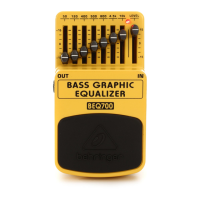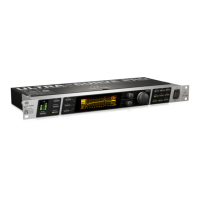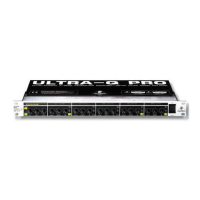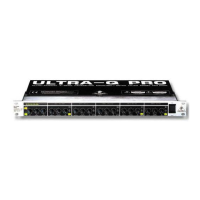5 FEEDBACK DESTROYER FBQ1000 User Manual
1. Introduction
1.1 The design concept
The philosophy behind BEHRINGER products guarantees a no-compromise
circuit design and employs the best choice of components. A 24-bit DSP is
used as the heart of the FEEDBACK DESTROYER, which belongs to the best
components available owing to its outstanding specications and excellent sonic
characteristics. What is more, high-quality 24-bit A/D and D/A converters ensure
the accurate processing of all signals. Additionally, the FEEDBACK DESTROYER
uses high-quality resistors and capacitors with very tight tolerances, high-grade
switches, and further selected components.
The FEEDBACK DESTROYER employs SMD technology (Surface Mounted Device).
These subminiature components known from aerospace technology allow for
an extreme packing density and improve the unit’s reliability even further.
Additionally, the FBQ1000 was manufactured in compliance with an ISO9000
certied management system.
1.2 Before you begin
Your FEEDBACK DESTROYER was carefully packed in the factory and
the packaging was designed to protect the unit from rough handling.
Nevertheless,werecommend that you carefully examine the packaging and its
contents for any signs of physical damage, which may have occurred in transit.
◊ If the unit is damaged, please do not return it to us, but notify your
dealer and the shipping company immediately, otherwise claims for
damage or replacement may not be granted. Shipping claims must be
made by the consignee.
The BEHRINGER FEEDBACK DESTROYER requires one standard 19" unit of
rack space. Please allow at least an additional 4" depth for the connectors on the
backpanel.
Be sure that there is enough space around the unit for cooling and please do not
place the FEEDBACK DESTROYER on high-temperature devices such as power
ampliers, etc. to avoid overheating.
◊ Before you connect your FEEDBACK DESTROYER to the mains,
please make sure that your local voltage matches the voltage required
by the unit:
The fuse holder on the female mains connector has 3 triangular markings, with
two of these triangles opposing each other. The FEEDBACK DESTROYER is set to the
operating voltage printed next to these markers and can be set to another voltage
by turning the fuse holder by 180°. CAUTION: This instruction does not apply to
export models exclusively designed, e.g. for 115-V operation!
Please use the enclosed power cord to connect the unit to the mains. The cord
complies with all applicable safety standards.
◊ Please note that all units must be grounded properly. For your own
safety, you should never remove any ground connectors from electrical
devices or power cords or render them inoperative.
As a standard, the BEHRINGER FEEDBACK DESTROYER is equipped with
electronically servo-balanced inputs and outputs. The circuit design features
automatic hum and noise reduction for balanced signals and thus allows for
trouble-free operation, even at high operating levels. Externally induced mains
hum, etc. will be eectively suppressed. The automatic servo-function recognizes
the presence of unbalanced connectors and adjusts the nominal level internally
to avoid level dierences between the input and output signals (6-dB correction).
The MIDI interfaces IN, OUT, and THRU are on standardized DIN connectors.
Dataare transmitted via potential-free opto couplers.
1.3 Background: How is feedback produced?
A feedback loop is produced when a microphone signal is reproduced by an
amplication system and is subsequently picked up again (with identical phase)
by the microphone. If this happens repeatedly, such a feedback loop can become
ever more persistent.
Fig. 1.1: How a feedback loop is produced
1.3.1 Background: front of house mix (FOH)
There are two main sections in any sound reinforcement system, which are liable
to produce feedback: the rst section is the so-called front of house mix (FOH),
i.e. the “public address” mix, which is reproduced by one or several ampliers
plus several loudspeakers directed at the audience.
1.3.2 Background: monitor mix
The monitor mix, which is often derived from the same console, feeds one or
several stage-mount monitor speakers. Unlike FOH systems, stage monitors
are used to provide the individual musicians with a monitor signal, because it
is often dicult to hear oneself or each other on the stage, which can be due
to the high volume levels produced by the FOH systems, or to dierent volume
levels of the stage-mount instruments and ampliers. It is therefore not unusual
to give each musician his or her own monitor speaker, which is why there are
usually several monitor speakers placed along the stage. This is the only way to
provide each musician with a directed and focused monitor signal. In an ideal
situation, eachmonitor provides a specic mix, comprising e.g. vocals, drums and
keyboards, foreach individual musician on the stage.
Unfortunately, it is anything but easy to nd perfect positions for the various
stage monitors, because the distance between speaker and microphone must be
kept very short, which in turn increases the risk of feedback.
◊ In contrast to FOH systems, it is common practice to create two or even
more dedicated monitor mixes, which also involves the use of several
monitor speakers. Again, this can lead to increased feedback.

